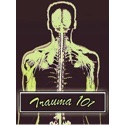The Biological Nature of Trauma

In his work, Healing Trauma, Peter Levine, Ph.D., writes:
Human responses to threat are primarily instinctive and biological, and secondarily psychological and cognitive.They comprise three innate action plans: fight, flight, and freeze-common to all mammals. When we sense threat, our bodies and minds enter the first stage of what is called the arousal cycle . Our muscles tense, and we begin to search for the source of possible danger. If we locate this source and perceive it to be a real threat, then we enter the second stage. Mobilized, our bodies and minds begin to produce adrenaline and cortisol, the two primary chemicals that energize us to fight or flee. In the third stage, we discharge this energy by completing the appropriate defensive actions (namely, fighting or fleeing). The fourth and final stage ensues when the nervous system, no longer aroused, returns to a state of equilibrium. If are overwhelmed by a threat and are unable to fight or flee, we instinctively employ the third action plan the "freezing response". This defensive maneuver serves two purposes:
1.) It may fool the attacker into losing interest, allowing us a chance to escape and
2.) We will not suffer any pain if we are injured or killed while in this state, because in immobility, consciousness seems to leave the body (dissociation).

Here’s the Problem
Even though we are immobilized, our nervous system is still highly aroused. Since we have been unable to discharge any of the fight-or-flight energy that our body has mobilized, we are left us in a state like that of a car whose accelerator and brakes are being floored at the same time. It is impossible to complete the arousal cycle if one can't move! Animals who survive an attack by using the freezing response simply allow for the biological discharge of excess energy and completion of the arousal cycle. Instinctively, animals tremble in a way that restores spontaneous breathing and allows the nervous system to regain its balance.
Watch video of polar bear discharging fight/flight energy
You’ve seen dogs shake and heard the coach say shake it off , right? Unfortunately, we humans have a much harder time actually shaking it off . This for difficult for human beings because the intensity of survival energy frightens us, and we are not comfortable giving in to involuntary (unconscious) sensations. Unfortunately, our rational brains often override this physiological completion process. When this happens, the nervous system remains in a state of arousal. Even if the threat is gone, the brain and body continue responding- spewing out the fight-or-flight chemicals.
The Biology of PTSD with Peter Levine, Ph.D. and Robert Scaer, M.D.
In a three-part series, the world’s leading trauma researchers and clinicians share their knowledge and perspectives on the nature of trauma.
The DVD with the Full Interviews can be purchased here.
Clusters of Trauma Symptoms in Chronological Order (more or less)
First Set of Symptoms...
Hypervigilance.
Extreme sensitivity to light and sound.
Restlessness, agitation.
Heightened startle reactions.
Insomnia.
Increased Physiological Arousal, i.e. increased heart rate, difficulty breathing, cold sweats, tingling, increased muscular tension intrusive imagery or flashbacks
Nightmares and night terrors.
Affect dysregulation: abrupt mood swings.
Reduced ability to deal with stress.
Racing thoughts and worry.
Followed by:
Panic attacks.
Agitation.
Anxiety.
Avoiding certain circumstances that remind us of previous traumas.
Exaggerated or diminished sexual activity.
Abrupt mood swings.
Dissociation.
Frequent anger or crying.
Attraction to dangerous situations.
Amnesia.
Fear of dying or having a shortened life.
Feelings of helplessness.
Avoidance of loved ones.
Isolation.
And Finally:
Chronic fatigue, very low physical energy.
Immune system and certain endocrine problems.
Thyroid dysfunction.
Psychosomatic Illnesses.
Headaches.
Neck and back problems.
Asthma.
Irritable bowel syndrome.
Spastic colon.
Severe PMS.
Eating disorders.
Excessive shyness.
Blunted emotional responses.
Depression.
Feelings of impending doom (waiting for the other shoe to drop).
Inability to make commitments.
Disconnection from others (feeling different, not like other people).
Feelings of detachment and alienation.
Spiritual disconnection.
